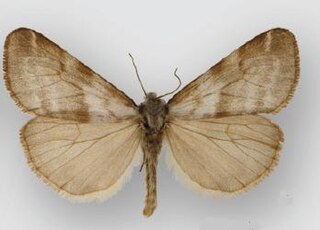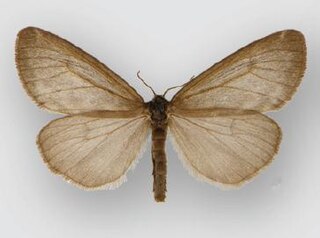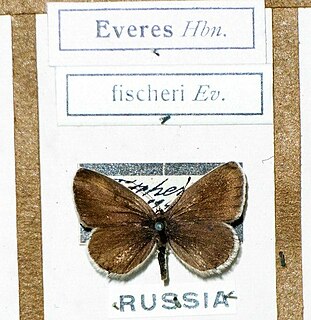
The greater short-toed lark is a small passerine bird. The current scientific name is from Ancient Greek. The genus name, Calandrella, is a diminutive of kalandros, the calandra lark, and brachydactila is from brakhus, "short", and daktulos, "toe".

Leymus is a genus of plants in the grass family Poaceae (Gramineae). It is widespread across Europe, Asia, and the Americas.

Alexander Eduard Friedrich Eversmann was a Prussian biologist and explorer.

The long-tailed ground squirrel or Eversmann's souslik is a species of rodent in the squirrel family Sciuridae. It is found in China, Kazakhstan, Mongolia, and Russia.

Boloria is a brush-footed butterfly (Nymphalidae) genus. Clossiana is usually included with it nowadays, though some authors still consider it distinct and it seems to warrant recognition as a subgenus at least.

Borearctia is a monotypic of tiger moth genus in the family Erebidae erected by Vladimir Viktorovitch Dubatolov in 1984. Its only species, Borearctia menetriesii, or Menetries' tiger moth, was first described by Eduard Friedrich Eversmann in 1846. It is found in Karelia, Oktyabrskoe, north-eastern Kazakhstan, Altai Mountains, Sayan Mountains, Evenkia, Yakutia, the central Amur region, Primorsky Krai and central Sakhalin. It was believed to be extinct in Fennoscandia, but the species has been recently recorded in Finland. This species is characterized by the fact that they never come to light; such behavior is atypical in the family Arctiidae.

Dodia is a genus of woolly bear moths in the family Erebidae. The genus was erected by Harrison Gray Dyar Jr. in 1901. The moths are found in subarctic tundra and taiga ecosystems. They belong to the subtribe Callimorphina of tribe Arctiini.

Loxostege is a genus of moths of the family Crambidae.

Dodia albertae is a moth of the family Erebidae first described by Harrison Gray Dyar Jr. in 1901. It is found in Canada, Siberia south to Mongolia, west to the Polar Urals. See the subspecies section for more information.

Agrotis ruta is a moth of the family Noctuidae first described by Eduard Friedrich Eversmann in 1851. It has a Holarctic distribution. In North America it has a northern distribution, occurring from Alaska and the Yukon Territory to Labrador, south to northern Manitoba and British Columbia, and in the Rocky Mountains to southern Alberta. Furthermore, it can be found in the northern Urals, Siberia, Mongolia, China and Japan.

Heliothis ononis, the flax bollworm, is a moth of the family Noctuidae. The species was first described by Michael Denis and Ignaz Schiffermüller in 1775. It is found in China, Kazakhstan, central Asia, northern Mongolia (Khangai), the Russian Far East, the Korean Peninsula, southern European part of Russia, southern and central Europe, southern and eastern Siberia and Turkey. In North America it is found from south-central Manitoba west to British Columbia, north to the Northwest Territories and Yukon and Alaska and south to Colorado.

Caeneressa diaphana is a moth in the family Erebidae first described by Vincenz Kollar in 1844. It is found from India to southern China, Taiwan and Sundaland.

Acossus terebra is a species of moth of the family Cossidae. It is found in Eurasia, including Israel, Turkey, northern Spain, central and southern Europe, southern Sweden, Finland, the Baltic region, Ukraine, the central part of European Russia, the Caucasus, southern Siberia to southern Yakutia, the southern part of the Russian Far East, Korea, Heilongjiang, Jilin and inner Mongolia.
Manulea atratula is a moth of the family Erebidae. It is found in Russia, Mongolia and North Korea.

Oeneis magna is a butterfly of the family Nymphalidae. It was described by Ludwig Carl Friedrich Graeser in 1888. It is found from the Altai Mountains to southern Siberia and the Russian Far East, Mongolia, northern China and Korea. The habitat consists of sparse woodlands and mountain tundras.
Oeneis urda is a butterfly of the family Nymphalidae. It was described by Eduard Friedrich Eversmann in 1847. It is found from Russia to northern Mongolia, north-eastern China and Korea. The habitat consists of steppe-clad slopes.

Tongeia fischeri, or Fischer's blue, is a butterfly of the family Lycaenidae. It was described by Eduard Friedrich Eversmann in 1843. It is found in south-eastern Europe, the southern Ural, northern and eastern Kazakhstan, south-western and southern Siberia, the Russian Far East, Mongolia, China, Korea and Japan.
Platarctia ornata is a moth in the family Erebidae. It was described by Otto Staudinger in 1896. It is found in the Russian Far East and Mongolia.














